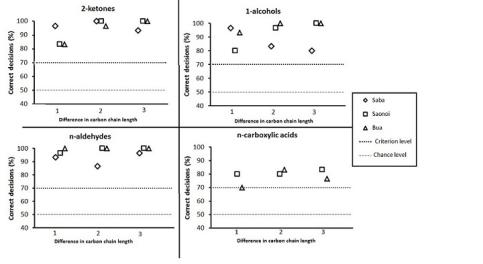Odor discrimination with structurally related aliphatic odorants
The three elephants were presented with aliphatic ketones, aliphatic alcohols and aliphatic aldehydes. Two elephants were presented with aliphatic carboxylic acids (Saba did not participate in this task). Each group of odorants allowed for three combinations which were tested with each elephant for two sessions.
For aliphatic ketones the rewarded odor, 2-heptanone was kept consistent while 2-butanone, 2-pentanone and 2-hexanone were altered.
For aliphatic alcohols the rewarded odor, 1-heptanol was kept consistent while 1-butanol, 1-pentanol and 1-hexanol were altered.
For aliphatic aldehydes the rewarded odor, n-heptanal was kept consistent while n-butanal, n-pentanal and n-hexanal were altered.
For aliphatic carboxylic acids the rewarded odor , n-heptanoic acid was kept consistent while n-butanoic acid, n-pentanoic acid and n-hexanoic acid were altered.
All three individual performed above criterion level (p<0.05) for all aliphatic odorants tested (except Saba in the carboxylic acid task). This results show that elephants can discriminate between odorants from the same chemical class even if they only differ by one carbon atom.
These graphs show the results of the first session for all aliphatic groups

When comparing the Asian elephants with other species tested previously on the same aliphatic odor pairs, the results show that Asian elephants are at least as good at discriminating aliphatic alcohols, aldehydes, ketones and carboxylic acids as other animals. This is not surprising since they strongly rely on their sense of smell (Greenwood et al., 2005; Langbauer 2000; Rasmussen 2006; Rasmussen and Krishnamurthy 2000; Scott and Rasmussen 2005; Schulte and Rasmussen 1999; Sukumar 2003).
All aliphatic odorants tested here are found in nature and are likely to be a part of the Asian elephant’s chemical environment. Some of the aldehydes, ketones, alcohols or carboxylic acids have also been reported in the temporal gland secretions of male elephants in musth and in the urine of females (Rasmussen et al. 1990; Rasmussen, et al. 1997; Rasmussen, 1998; Rasmussen and Krishnamurthy 2001; Rasmussen and Wittemyer 2002; Rasmussen et al. 2005).
Responsible for this page:
Director of undergraduate studies Biology
Last updated:
05/08/12
